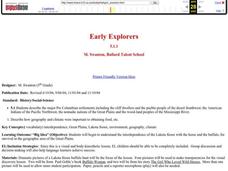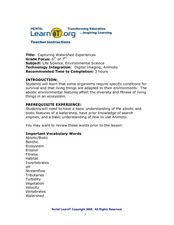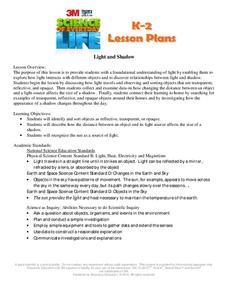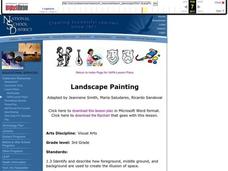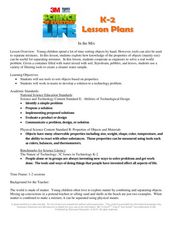Curated OER
Napolean Triangle
Learners investigate the Napoleon triangle theory. In this polygon lesson plan, students differentiate between the boundary points, interior and lattice point of a polygon. They apply concepts of equilateral triangles to solve...
Curated OER
Innovation of Our Generation
Students identify the innovations that have impacted their lives. In this inventions lesson plan students write and present a speech on the greatest innovation of their generation.
Curated OER
Early Explorers
Fifth graders examine how the environment and climate affected Pre-Colombian settlements. In this civilization instructional activity, 5th graders view pictures of different Native American tribes in different places and discuss how...
Curated OER
Capturing Watershed Experiences
Students observe organisms found in the water. In this lesson on organisms, students collect water from local streams and tributaries in order to study the organisms found in the water. As a culminating activity, students create a...
Curated OER
Impact of Ancient Rome on Life Today
Students research the importance of ancient Rome to the world today. In this ancient Rome lesson, students view video and research to gather information for a slide show about Ancient Rome.
Benjamin Franklin Tercentenary
Guess What Benjamin Franklin Did!
Students research Ben Franklin's inventions. For this invention lesson, students see the relationship between a need and an invention. Students will engage in a class discussion, read a handout, and play a match the invention to its...
Curated OER
Weather in Your City
Students observe weather conditions of a particular city. Multiple intelligences are explored within this lesson. They locate their particular city on a United States map. Each student writes about their discoveries in his/her journal...
Curated OER
Light and shadow
Young scholars experiment with light and shadow. In this light activity, students look at the relationship between shadows and light. They experiment with light source, shadow size, transparent objects and reflective objects.
Curated OER
Art and Anatomy: The Vitruvian Teen
Twelfth graders create an artistic version of a Vetruvian teen. In this anatomy lesson plan, 12th graders design an experiment to test the theory of the ideally proportioned man. They present their findings in class.
Curated OER
Journey to the Unknown
Students explore the ocean depths. In this scenario based lesson, students pretend they are on a submarine in an unknown part of the ocean. By using clues the class discusses and determines where they are in the ocean. They follow up...
Curated OER
Native American Basket Making
Students design a unique basket plaque incorporating at least one symbol from their chosen tribe. They also identify, share, and give rationales for the symbols in basket plaques. Whole class discussion jig-saws their discoveries.
Curated OER
Comparing Cultural Holidays
Third graders explore art that reflects their cultural background. In this writing and research lesson students compare and contrast the Halloween with El Dia de los Muertos. Students study the visual art of these holidays. Then students...
Curated OER
Our Inventions
Students construct or draw an invention of their own design. In this problem solving lesson, students define the word invention, discuss famous inventions, invetors, and how inventions come about. Students work in groups to...
Curated OER
Let's Build a Map
Students gain an understanding of maps while studying the map of the Louisiana Purchase and the trail of Lewis and Clark and the Corps of Discovery. They demonstrate understanding of maps by creating a basic classroom map.
Curated OER
Climbing Mount Everest
Students use the Discovery Channel's webstie to take a virtual tour of Mount Everest. They read about different people who have climbed the mountain successfully. They also compare the gear used today and in the past for climbing.
Curated OER
Living and Nonliving
Students use their senses to record and collect data. In How Do I Classify Things in My World?, students practice classifying objects as living or nonliving. In Is it Real Or Pretend?, students group objects as real or pretend. In What...
Curated OER
People Change the Landscape
Students examine ways in which humans have brought change to the natural environment. In this ecology and literacy lesson, students listen to the book Island Boy by Barbara Cooney. Students observe and define map-reading vocabulary as...
Curated OER
Landscape Painting
Third graders paint a landscape that demonstrates the illusion of space. In this visual arts lesson, 3rd graders paint a creek with reflections as the focus and include images showing foreground, middle ground, and background...
Curated OER
Study of Fossils
Fifth graders dig for fossils. In this fossil lesson, 5th graders read about the oldest found fossils and discuss the process of fossilization. They dig for their own fossils in a fossil box made of several dirt layers.
Curated OER
In the Mix
Students construct a water filter. In this engineering lesson, students discover how to construct a water filtration system. Students work in groups to sort tools by their properties. Students analyze and construct a water filtration...
Curated OER
Less is More: Realizing Mathematics Through Agriculture
High schoolers study the architectural designs of different popular sites. In this math lesson, students draw a grid diagram. They explain what geodesic algorithms are used for.
Curated OER
Fun With Adhesives
Students observe, measure, and record the properties in making objects stick together using science tools. In this science lesson, students explore with their senses while mixing flour and water. Additionally, students share their...
Curated OER
Life Along the Trail
Students explore the significance of the Louisiana Purchase and the journey of Lewis and Clark's Corps of Discovery. They read to explain a new topic and write to inform readers of the historic events they explored.
Curated OER
Interaction at a Distance
Students explore magnetism. In this magnetism lesson, students discover the purpose of different magnets. Students perform an experiment by testing the magnetism through different items. Students collect data on the experiment.


